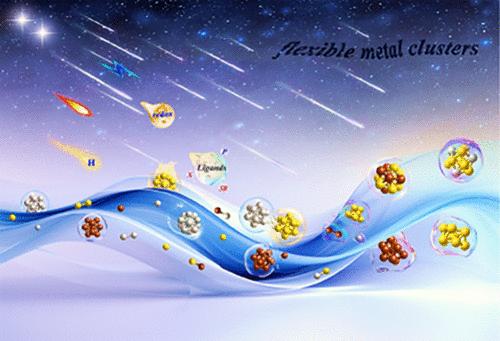当前位置:
X-MOL 学术
›
Chem. Rev.
›
论文详情
Our official English website, www.x-mol.net, welcomes your
feedback! (Note: you will need to create a separate account there.)
Chemical Flexibility of Atomically Precise Metal Clusters
Chemical Reviews ( IF 51.4 ) Pub Date : 2024-05-02 , DOI: 10.1021/acs.chemrev.3c00896 Si Li 1 , Na-Na Li 1, 2 , Xi-Yan Dong 1, 2 , Shuang-Quan Zang 1 , Thomas C W Mak 1, 3
Chemical Reviews ( IF 51.4 ) Pub Date : 2024-05-02 , DOI: 10.1021/acs.chemrev.3c00896 Si Li 1 , Na-Na Li 1, 2 , Xi-Yan Dong 1, 2 , Shuang-Quan Zang 1 , Thomas C W Mak 1, 3
Affiliation

|
Ligand-protected metal clusters possess hybrid properties that seamlessly combine an inorganic core with an organic ligand shell, imparting them exceptional chemical flexibility and unlocking remarkable application potential in diverse fields. Leveraging chemical flexibility to expand the library of available materials and stimulate the development of new functionalities is becoming an increasingly pressing requirement. This Review focuses on the origin of chemical flexibility from the structural analysis, including intra-cluster bonding, inter-cluster interactions, cluster-environments interactions, metal-to-ligand ratios, and thermodynamic effects. In the introduction, we briefly outline the development of metal clusters and explain the differences and commonalities of M(I)/M(I/0) coinage metal clusters. Additionally, we distinguish the bonding characteristics of metal atoms in the inorganic core, which give rise to their distinct chemical flexibility. Section 2 delves into the structural analysis, bonding categories, and thermodynamic theories related to metal clusters. In the following sections 3 to 7, we primarily elucidate the mechanisms that trigger chemical flexibility, the dynamic processes in transformation, the resultant alterations in structure, and the ensuing modifications in physical–chemical properties. Section 8 presents the notable applications that have emerged from utilizing metal clusters and their assemblies. Finally, in section 9, we discuss future challenges and opportunities within this area.
中文翻译:

原子级精确金属簇的化学灵活性
配体保护的金属簇具有混合特性,可以将无机核与有机配体壳无缝结合,赋予它们卓越的化学灵活性,并在不同领域释放出显着的应用潜力。利用化学灵活性来扩大可用材料库并刺激新功能的开发正成为日益紧迫的要求。本综述重点关注结构分析中化学灵活性的起源,包括簇内键合、簇间相互作用、簇-环境相互作用、金属与配体比率和热力学效应。在引言中,我们简要概述了金属簇的发展,并解释了M(I)/M(I/0)造币金属簇的差异和共性。此外,我们还区分了无机核中金属原子的键合特征,这导致了它们独特的化学灵活性。第 2 部分深入研究与金属团簇相关的结构分析、键合类别和热力学理论。在接下来的第3至7节中,我们主要阐明触发化学灵活性的机制、转化的动态过程、由此产生的结构变化以及随之而来的物理化学性质的改变。第 8 节介绍了利用金属簇及其组件产生的显着应用。最后,在第 9 节中,我们讨论了该领域未来的挑战和机遇。
更新日期:2024-05-02
中文翻译:

原子级精确金属簇的化学灵活性
配体保护的金属簇具有混合特性,可以将无机核与有机配体壳无缝结合,赋予它们卓越的化学灵活性,并在不同领域释放出显着的应用潜力。利用化学灵活性来扩大可用材料库并刺激新功能的开发正成为日益紧迫的要求。本综述重点关注结构分析中化学灵活性的起源,包括簇内键合、簇间相互作用、簇-环境相互作用、金属与配体比率和热力学效应。在引言中,我们简要概述了金属簇的发展,并解释了M(I)/M(I/0)造币金属簇的差异和共性。此外,我们还区分了无机核中金属原子的键合特征,这导致了它们独特的化学灵活性。第 2 部分深入研究与金属团簇相关的结构分析、键合类别和热力学理论。在接下来的第3至7节中,我们主要阐明触发化学灵活性的机制、转化的动态过程、由此产生的结构变化以及随之而来的物理化学性质的改变。第 8 节介绍了利用金属簇及其组件产生的显着应用。最后,在第 9 节中,我们讨论了该领域未来的挑战和机遇。











































 京公网安备 11010802027423号
京公网安备 11010802027423号